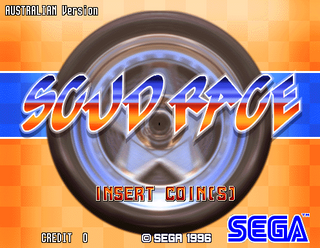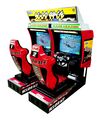Difference between revisions of "Scud Race"
From Sega Retro
(→Tracks) |
|||
| Line 58: | Line 58: | ||
}} | }} | ||
===Tracks=== | ===Tracks=== | ||
| + | According to promotional material, every track in ''Scud Race'' is located in the fictional world of "Versus City", potentially named after one of Sega's multi-purpose arcade cabinets available at the time. | ||
{{sections | {{sections | ||
| section1name=Beginner (Day)/Dolphin Tunnel | | section1name=Beginner (Day)/Dolphin Tunnel | ||
| section1image=ScudRace BeginnerDay.png | | section1image=ScudRace BeginnerDay.png | ||
| − | | section1desc=Beginner (Day), also known as Dolphin Tunnel, is the easiest of the four tracks in ''Scud Race'', and the most iconic. It is a simple track which takes place across a modern city. Much of this track actually takes place underwater - there is a pair of tunnels with glass frames (collectively known as "Dolphin Tunnel") which travel beneath a river. | + | | section1desc=''Fast-paced race through the international marine exposition at Versus City.'' |
| + | |||
| + | Beginner (Day), also known as Dolphin Tunnel, is the easiest of the four tracks in ''Scud Race'', and the most iconic. It is a simple track which takes place across a modern city. Much of this track actually takes place underwater - there is a pair of tunnels with glass frames (collectively known as "Dolphin Tunnel") which travel beneath a river. | ||
| + | |||
| + | There is also a tower preceding a bridge with a rotating [[Sega Saturn]] logo, as well as a poster showing [[Sonic the Hedgehog]] and [[sonic:Miles "Tails" Prower|Miles "Tails" Prower]] driving what seems to be a Ferrari F40. | ||
| − | |||
| section2name=Beginner (Night)/Twilight Airport | | section2name=Beginner (Night)/Twilight Airport | ||
| section2image=ScudRace BeginnerNight.png | | section2image=ScudRace BeginnerNight.png | ||
| − | | section2desc=Beginner (Night), also known as Twilight Airport, is also an easy track. This one takes place around an airport. The two beginner stages have rolling starts, similar to ''Daytona USA''. | + | | section2desc=''Night driving through the Versus City raceway at speeds of 330km/hour!'' |
| + | |||
| + | Beginner (Night), also known as Twilight Airport, is also an easy track. This one takes place around an airport. The two beginner stages have rolling starts, similar to ''Daytona USA''. | ||
| + | |||
| section3name=Medum/Mystic Ruins | | section3name=Medum/Mystic Ruins | ||
| section3image=ScudRace Medium.png | | section3image=ScudRace Medium.png | ||
| − | | section3desc=Medium, also known as Mystery Ruins, is a more challenging track which requires more use of the drift mechanic. It is set in an Aztec ruin-esque mountainous region with several foggy segments. There are only 30 racers on this track by default and there are only three laps. | + | | section3desc=''Fiery race through ancient ruins located in the mountains of Versus City.'' |
| + | |||
| + | Medium, also known as Mystery Ruins, is a more challenging track which requires more use of the drift mechanic. It is set in an Aztec ruin-esque mountainous region with several foggy segments. There are only 30 racers on this track by default and there are only three laps. | ||
| + | |||
| section4name=Expert/Classic Castle | | section4name=Expert/Classic Castle | ||
| section4image=ScudRace Expert.png | | section4image=ScudRace Expert.png | ||
| − | | section4desc=Expert, also known as Classic Castle, is the hardest track in the game and has a European setting. | + | | section4desc=''The traditional race held in the hills of Versus City, where player drivers through detailed castle scenes and in a colliseum.'' |
| + | |||
| + | Expert, also known as Classic Castle, is the hardest track in the game and has a European setting, complete with French and Spanish imagery. The majority of the track's turns and locations are named after signs of the zodiac. | ||
Only 20 racers are on this track at any given time, with three laps given to try and overtake them all. | Only 20 racers are on this track at any given time, with three laps given to try and overtake them all. | ||
Revision as of 11:46, 12 January 2013
| Scud Race | |||||
|---|---|---|---|---|---|
| System(s): Sega Model 3 Step 1.5 | |||||
| Publisher: Sega | |||||
| Developer: Sega AM2 | |||||
| Genre: Racing | |||||
| Number of players: 1-4 | |||||
|
Scud Race, known as Sega Super GT in North America, is a racing game developed by Sega AM2 for Sega Model 3 Step 1.5 hardware in late 1996. Its working title was simply Supercar, though European flyers suggest that at one point the Scud Race name wasn't deemed final either. "Scud" stands for "Sport Car Ultimate Drive".
Scud Race was released to demonstrate the capabilities of the Model 3 hardware, containing many bright, colourful and detailed stages rendered at fast speeds while retaining a 60FPS refresh rate. It stands alongside Virtua Fighter 3 as one of the first Model 3 racing game to be released.
Scud Race is a spiritual sequel to Daytona USA with very similar controls, HUD and visual style, exchanging NASCAR-style stock cars for GT supercars. The core engine powering the game does not differ significantly from Daytona USA due to supposed time restraints - major improvements would not be seen in that area until Daytona USA 2: Battle on the Edge.
Contents
Gameplay
Scud Race follows the same basic gameplay rules as Daytona USA, as both games share the same game engine. It it is a racing game in which the player competes against several dozen computer controlled cars in an attempt to finish first. As an "arcade style" racer, much of the "realism" is taken out of the equation in order to provide the user with a fast paced, entertaining experience - cars do not handle like they would in reality, but rather how users would want these cars to handle.
Like Daytona USA, Scud Race is based on a real life racing event - the BPR Global GT Series, being sponsored by the BPR Organization. It also features four real-life cars - the Porsche 911 GT2, the Ferrari F40 GTE, the Dodge Viper GTS-R and the McLaren F1 GTR, all of whom could be spotted in the 1995 season. Renault Alpine GTA/A610s are also featured, but are driven by the computer and cannot be selected by the player.
One of the only major changes of Scud Race is the drifting system, as players can now accelerate while drifting.
Cars
Tracks
According to promotional material, every track in Scud Race is located in the fictional world of "Versus City", potentially named after one of Sega's multi-purpose arcade cabinets available at the time. Template:Sections
Sequels and Rereleases
Scud Race was due to be ported to the Sega Saturn, though the vast differences in hardware capabilities meant development moved over to the Sega Dreamcast (similar to Virtua Fighter 3). The Dreamcast version of the game was used in a tech demo in the 1998 Dreamcast Presentation, but the port was cancelled for unknown reasons. Some Dreamcast development kits have sections of Scud Race built in for example purposes.
Unlike Daytona USA, the BPR Global GT Series no longer exists as a sport (and in fact, was discontiuned in 1997 - a year after Scud Race's release), and so may explain why Scud Race was never brought to home consoles. GT racing games (such as Sega GT and its sequels) would stil lbe released by the company in the years that follow, but none follow the "arcade style" gameplay seen here.
Despite seeing no console release of its own, the four tracks in Scud Race appear in the Xbox port of OutRun 2, complete with original music. An updated version of the game, Scud Race Plus and an official soundtrack would be released in Japan.
Production Credits
Producer & game director: Toshihiro Nagoshi
Programmers: Takuji Masuda (program director), Kouki Koiwa, Takashi Fujimura, Kazuhiko Takata, Takashi Isowaki, Takayuki Kazama, Ryo Ikawa
Designers: Yasuo Kawagoshi (design director), Daisuke Sato, Akihito Hiroyoshi, Junichi Yamanaka, Yukinobu Arikawa, Makio Kida, Kazufumi Ohashi, Hidenobu Miyakita, Junichi Yamada, Makoto Osaki, Kazuhiro Izaki, Naotake Nishimura, Shinichiro Shimano
Sound: Hideaki Miyamoto, Toru Nakabayashi, Fumio Ito, Hidenori Shoji
- Digital Media Studio: Tatsutoshi Narita, Naoyuki Machida
- YUMEX: Junji Fujita, Kaoru Ohori, Hiroko Hamano
Cabinet Engineers: Masao Yoshimoto (mechanical supervisor), Eiji Nishimura, Eiji Inoue, Yumiko Ara, Hiroyuki Takahashi, Hideyuki Yamada, Mikio Tsuda, Keisuke Tsukahara
Publicity: Koji Umeda
Special Thanks: BPR Organization, Japan Airlines, Car Graphic, S.S. Company ltd., Cobra Company Japan, Yu Suzuki
Presented by: Sega
Gallery
Artwork
Physical Scans
Template:ScanflyerTemplate:ScanflyerTemplate:ScanflyerTemplate:ScanflyerTemplate:ScanflyerTemplate:ScanflyerTemplate:Scanflyer




